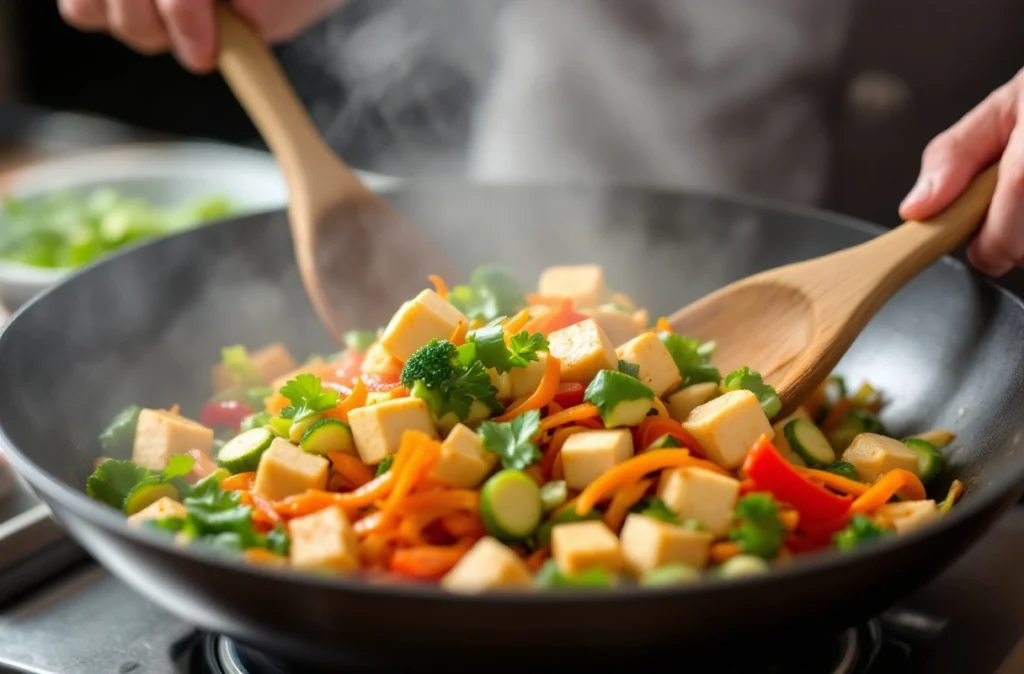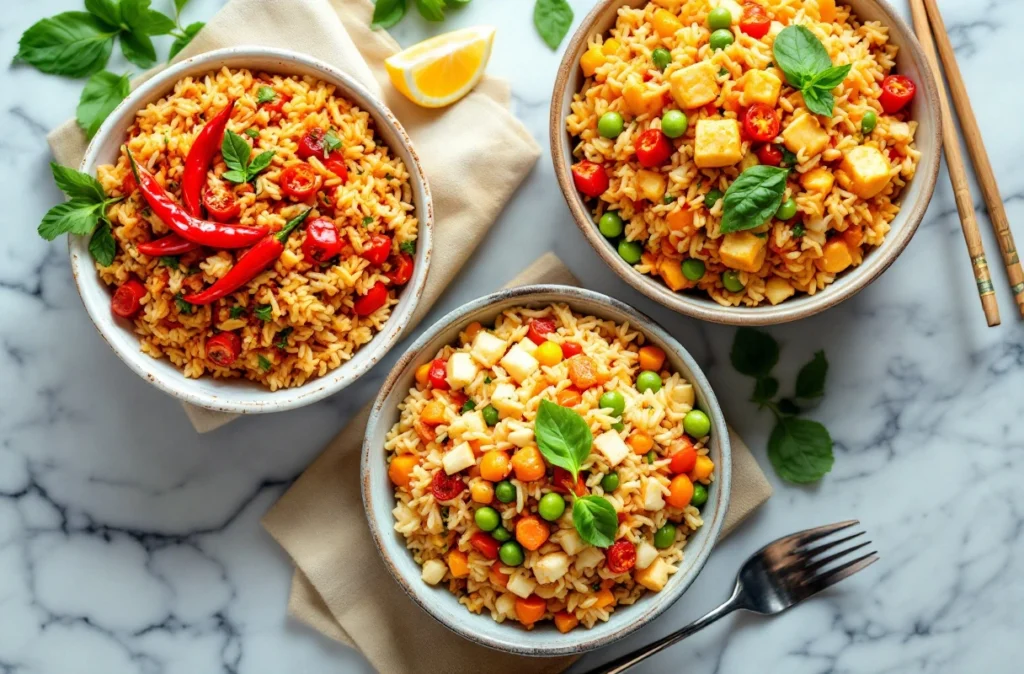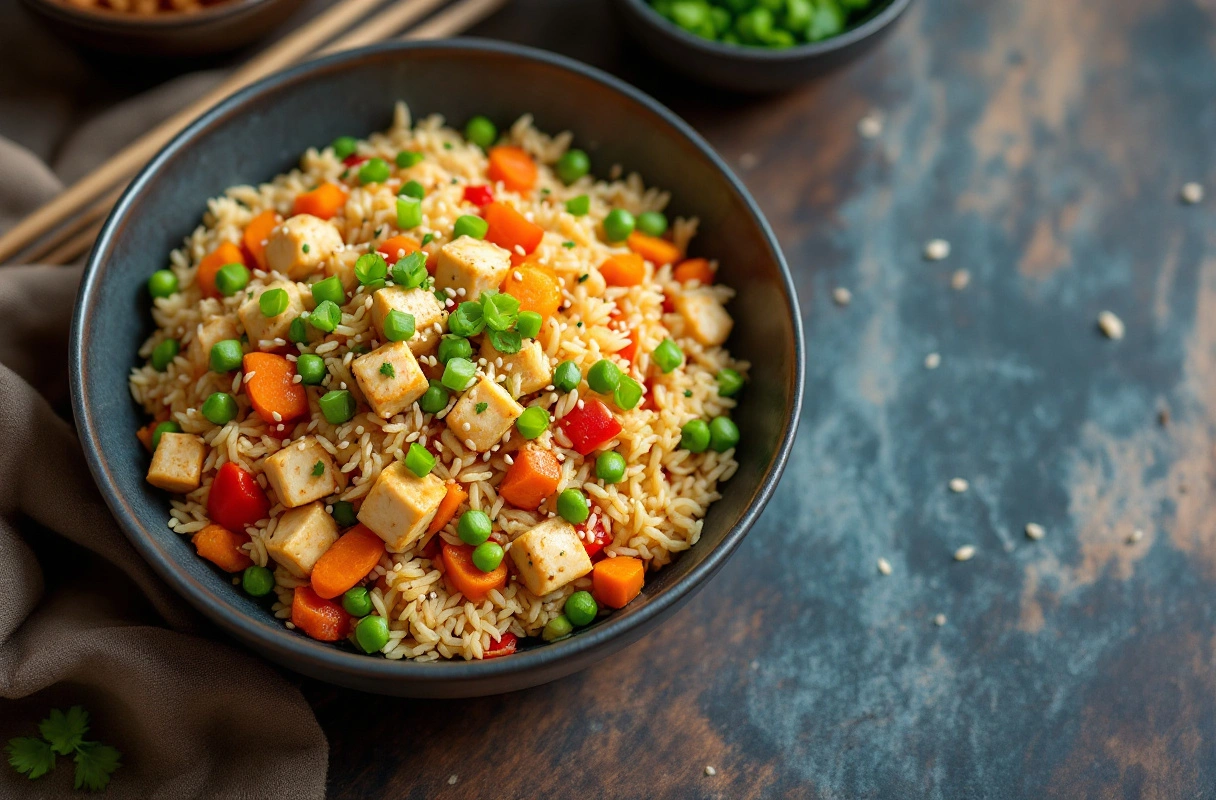If you’re craving a comforting yet healthy meal, this ultimate vegan fried rice recipe will become your new go-to. Packed with colorful veggies, bold flavors, and plant-based protein, it’s a dish that’s easy to whip up on a weeknight or impress your friends at a dinner party. Ready to learn the secrets to making the best vegan fried rice you’ve ever tasted? Let’s dive in!
Introduction to Vegan Fried Rice
Why Vegan Fried Rice is a Must-Try
Vegan fried rice is not just another plant-based dish — it’s a delicious celebration of flavor and texture. Imagine fluffy rice, crisp-tender veggies, and savory, umami-packed seasonings all tossed together in one irresistible pan. You don’t need eggs, meat, or dairy to make fried rice taste incredible. Instead, the right combination of soy sauce, sesame oil, garlic, and fresh vegetables brings out mouthwatering flavors that everyone — vegan or not — will love.
Not only is vegan fried rice super tasty, but it’s also incredibly versatile. You can customize it with whatever veggies you have in your fridge, making it a great way to use up leftovers and reduce food waste. Plus, it’s budget-friendly and can be made in under 30 minutes. Whether you’re meal prepping for the week, hosting a casual dinner, or just craving comfort food, vegan fried rice checks all the boxes — much like other favorites from the vegan Japanese recipes and vegan snack recipes collections.
History and Origins of Fried Rice
Fried rice has deep roots in Chinese cuisine, with a history that stretches back over a thousand years. Originally created as a way to use leftover rice and avoid waste, fried rice quickly became a beloved dish throughout Asia. Today, you can find variations of fried rice in almost every Asian country — from Thai basil fried rice to Japanese yakimeshi and Indonesian nasi goreng.
The beauty of fried rice lies in its adaptability. While traditional recipes often include eggs, meat, or seafood, the vegan version has carved out a special place in modern kitchens. By swapping in plant-based ingredients, you can still honor the dish’s rich heritage while creating something fresh, vibrant, and aligned with today’s dietary preferences.
Ingredients You’ll Need
Essential Ingredients
Here’s a basic list of what you’ll need to make vegan fried rice:
-
Rice: Day-old jasmine or long-grain rice works best.
-
Vegetables: Carrots, peas, corn, bell peppers, green onions.
-
Aromatics: Garlic, ginger, onion.
-
Soy sauce: Or tamari for a gluten-free option.
-
Sesame oil: Adds a nutty, toasty depth.
-
Tofu or tempeh: For a protein boost.
-
Salt and pepper: To taste.
These pantry staples are the foundation of vegan fried rice, but the real magic happens when you personalize it with your favorite add-ins.
Optional Add-ins for Extra Flavor
Want to level up your fried rice? Try these optional ingredients:
-
Mushrooms: Add a meaty texture.
-
Baby spinach or kale: Sneak in some greens.
-
Chili flakes or sriracha: For a spicy kick.
-
Cashews or peanuts: For crunch.
-
Pineapple: For a sweet-savory twist.
Adding these extras keeps the dish exciting and lets you tailor it to your mood or the season.
Ingredient Substitutions
If you’re missing an ingredient, don’t worry! Here are some easy swaps:
-
Soy sauce → Coconut aminos (for soy-free option)
-
Tofu → Chickpeas or edamame
-
Jasmine rice → Brown rice or quinoa
-
Sesame oil → Olive oil or avocado oil
Flexibility is the beauty of this dish — you can make it work with whatever you have on hand.
Tools and Equipment
Best Pan or Wok for Fried Rice
The right cookware can make or break your fried rice. A wok is the gold standard because its high sides and even heat distribution make tossing ingredients easy and prevent overcrowding. If you don’t have a wok, no worries — a large nonstick skillet or cast-iron pan works beautifully.
Look for a pan that:
-
Has a wide surface area for even cooking.
-
Heats up quickly and retains heat well.
-
Has a nonstick or well-seasoned surface to prevent sticking.
Other Useful Kitchen Tools
A few other tools can make the process smoother:
-
Sharp knife: For chopping veggies.
-
Spatula or wooden spoon: For stirring and tossing.
-
Mixing bowls: To prep ingredients in advance.
-
Rice cooker or pot: To prepare the rice (ideally the day before).
Prepping your tools and ingredients ahead of time will help you cook with confidence and avoid last-minute scrambling.
Step-by-Step Vegan Fried Rice Recipe

Preparing the Rice
Start with day-old rice — this is the #1 secret to perfect fried rice. Freshly cooked rice is too soft and steamy, which can lead to a mushy mess. Here’s how to prep it:
-
Cook your rice a day ahead: Use slightly less water than usual so it’s a bit drier.
-
Cool completely: Spread it on a baking sheet and let it cool before refrigerating.
-
Break up clumps: Before stir-frying, gently fluff the rice with your hands to separate the grains.
Using cold, dry rice gives you those signature crispy bits and light, fluffy texture that make fried rice irresistible.
Tips for Perfect Vegan Fried Rice Every Time
Best Type of Rice to Use
The type of rice you choose makes a huge difference. For the best texture and flavor, go with long-grain rice like jasmine or basmati. Why? Long-grain rice stays separate and fluffy, avoiding that clumpy, sticky mess that short-grain rice can create.
If you want to switch things up, you can also try:
-
Brown rice: For extra fiber and a nutty flavor.
-
Cauliflower rice: For a low-carb, veggie-packed version.
-
Quinoa: For a protein-rich, gluten-free option.
No matter what rice you use, remember: day-old rice is key. It dries out in the fridge overnight, so when you toss it in the pan, it crisps up beautifully instead of steaming.
How to Prevent Mushy Rice
Nobody wants a soggy plate of fried rice, right? Here’s how to dodge that pitfall:
-
Use day-old rice.
This can’t be said enough. Fresh rice has too much moisture and will steam instead of fry. -
Don’t overcrowd the pan.
When your pan’s too full, the ingredients steam instead of brown. Cook in batches if you need to. -
High heat is your friend.
Crank up the heat to get that signature wok hei — the slightly smoky, charred aroma that makes fried rice so addictive. -
Avoid too much sauce.
Go light on soy sauce or tamari; otherwise, your rice will get soggy. You can always drizzle more on later if needed. -
Toss, don’t stir.
Use a gentle tossing motion with a spatula or spoon to keep the grains from breaking apart.
Mastering these tips will transform your fried rice game from good to restaurant-worthy!
Balancing Flavors and Seasonings
Vegan fried rice shines when you strike the perfect balance between salty, savory, umami, and just a touch of sweetness. Here’s a simple guide:
-
Salty: Soy sauce, tamari, or coconut aminos.
-
Umami: Mushrooms, nutritional yeast, or a splash of vegan oyster sauce.
-
Sweet: A pinch of sugar, maple syrup, or diced pineapple.
-
Acidic: A squeeze of lime or rice vinegar.
-
Spicy: Chili flakes, sriracha, or gochujang.
Taste as you go, and don’t be afraid to adjust. A little tweak here and there can elevate your dish from good to unforgettable.
Variations and Creative Twists

Spicy Vegan Fried Rice
If you like it hot, you’ll love spicy vegan fried rice. Simply add:
-
Fresh chili peppers or jalapeños, finely sliced.
-
Sriracha, chili garlic sauce, or sambal oelek for a fiery kick.
-
A sprinkle of chili flakes or Korean gochugaru for depth.
Pair the heat with cooling elements like fresh herbs (cilantro or Thai basil) and a squeeze of lime. It’s a party of flavors in every bite!
Thai-Inspired Vegan Fried Rice
Take your fried rice on a trip to Thailand by adding:
-
Thai basil leaves for a fragrant, peppery twist.
-
Vegan fish sauce or soy sauce with a splash of lime.
-
Peanuts or cashews for crunch.
-
A hint of sugar to balance the saltiness.
Thai fried rice has a slightly sweeter profile, which pairs beautifully with the herbal punch of basil and the crunch of toasted nuts. It’s a fantastic way to change up your usual routine.
High-Protein Vegan Fried Rice
Want to boost the protein content? Try these upgrades:
-
Tofu: Press it, cube it, and pan-fry until golden.
-
Tempeh: Marinate and crumble it for a nutty, hearty addition.
-
Edamame: Toss in a handful of these green gems.
-
Chickpeas or black beans: For a fiber-packed punch.
Protein-packed vegan fried rice makes an awesome post-workout meal or a satisfying dinner that keeps you full for hours.
Nutritional Benefits of Vegan Fried Rice
Health Benefits of Main Ingredients
Vegan fried rice is more than just tasty — it’s packed with nutrients:
-
Carrots and bell peppers: Rich in vitamin A and antioxidants.
-
Peas and corn: Provide plant-based protein and fiber.
-
Tofu or tempeh: Excellent sources of protein and iron.
-
Brown rice or quinoa: High in fiber and complex carbs.
-
Garlic and ginger: Anti-inflammatory and immune-boosting.
When you load up your fried rice with a rainbow of veggies, you’re feeding your body a powerhouse of vitamins, minerals, and phytonutrients.
How to Make It Even Healthier
Looking to maximize nutrition? Here’s how:
-
Swap white rice for brown rice or quinoa.
This adds fiber and improves blood sugar balance. -
Add leafy greens.
Throw in spinach, kale, or bok choy for an iron and calcium boost. -
Go easy on oil.
Use a nonstick pan and reduce the amount of sesame or vegetable oil. -
Pile on the veggies.
The more variety, the better. Think broccoli, snap peas, zucchini, or mushrooms.
With a few tweaks, you can turn vegan fried rice into a nutrient-packed meal that supports your health and energy levels.
Common Mistakes to Avoid
Overcrowding the Pan
This is the #1 mistake people make. When you cram too much into your pan or wok, the heat drops, and everything steams instead of fries. The result? Soggy, sad rice.
Here’s how to avoid it:
-
Use the right size pan. A wok is best, but a large skillet works too.
-
Cook in batches. It might take a little longer, but the texture will be so much better.
-
Preheat the pan. Make sure it’s nice and hot before adding your ingredients.
A little patience goes a long way in making perfectly crisp vegan fried rice.
Using Fresh Rice Instead of Leftovers
We’ve said it before, but it’s worth repeating: use cold, leftover rice. Fresh rice is too moist and will clump together. If you’re in a pinch and only have fresh rice:
-
Spread it on a baking sheet.
-
Pop it in the fridge for at least 30 minutes.
-
Let it dry out a bit before using.
Trust me — your fried rice will thank you.
Pairing Suggestions
Best Vegan Side Dishes
Want to make your meal even more epic? Serve vegan fried rice with:
-
Spring rolls or summer rolls
-
Miso soup or hot and sour soup
-
Cucumber salad or Asian slaw
-
Steamed dumplings or potstickers
These sides add variety, texture, and flavor, turning your fried rice into a full-on feast.
Drinks That Complement Fried Rice
Round out your meal with the perfect drink:
-
Green tea or jasmine tea: Light and refreshing.
-
Coconut water: Sweet and hydrating.
-
A crisp white wine or sake: For a fancy touch.
-
Sparkling water with lime: Simple and refreshing.
The right drink balances the flavors and makes your meal feel complete.
Storage and Reheating Tips
How to Store Leftovers Properly
One of the best things about vegan fried rice is that it stores beautifully — if you do it right. Here’s how to keep it fresh:
-
Cool it completely before storing. Putting hot fried rice into the fridge traps moisture, making it soggy. Let it come to room temperature first.
-
Use an airtight container. This helps prevent the rice from drying out and keeps fridge odors away.
-
Label and date your container. Fried rice will last 3–4 days in the refrigerator — beyond that, the texture and flavor start to decline.
If you want to store it even longer, freezing is an option (we’ll cover that in the next section).
Best Reheating Methods
Reheating fried rice can be tricky — no one wants a sad, dry plate of leftovers. Here’s how to bring it back to life:
-
On the stovetop (best method):
-
Heat a bit of oil in a pan or wok over medium heat.
-
Add the rice and a splash of water or broth.
-
Stir-fry for a few minutes until heated through.
-
-
In the microwave (quickest method):
-
Place the rice in a microwave-safe bowl.
-
Cover with a damp paper towel to add moisture.
-
Heat in 30-second bursts, stirring between, until warm.
-
-
In the oven (for large batches):
-
Preheat to 350°F (175°C).
-
Spread rice on a baking sheet and cover with foil.
-
Bake for 15–20 minutes, stirring halfway.
-
With these tips, you’ll get fried rice that’s just as good as day one — maybe even better!
Meal Prep and Freezing Tips
Freezer-Friendly Fried Rice
Yes, you can freeze vegan fried rice! This makes it an awesome meal prep option for busy weeks. Here’s how:
-
Cool completely before freezing. This prevents ice crystals and keeps the texture intact.
-
Portion into freezer-safe containers or bags. Lay bags flat to save space.
-
Label and date. Frozen fried rice will keep for up to 3 months.
To reheat:
-
Thaw overnight in the fridge, then reheat on the stovetop or in the microwave.
-
Or reheat straight from frozen in a pan over medium-low heat, adding a splash of water or broth to help it along.
Batch Cooking for Busy Weeks
If you love having grab-and-go meals, batch cooking vegan fried rice is a game changer.
-
Double or triple the recipe.
-
Store in meal prep containers for individual portions.
-
Mix up the variations (like adding tofu to some, chickpeas to others) to keep things interesting.
With a little planning, you’ll have healthy, homemade lunches or dinners ready to roll all week long.
Frequently Asked Questions About Vegan Fried Rice
Can I Make It Gluten-Free?
Absolutely! To make your vegan fried rice gluten-free:
-
Use tamari or coconut aminos instead of soy sauce.
-
Double-check all packaged ingredients, like tofu, tempeh, or vegan oyster sauce, to ensure they’re gluten-free.
-
Avoid store-bought sauces with hidden gluten, like some stir-fry sauces or marinades.
With these simple swaps, you can enjoy all the flavor without worrying about gluten.
How Long Does It Last in the Fridge?
Vegan fried rice lasts:
-
3–4 days in the fridge when stored properly in an airtight container.
-
Up to 3 months in the freezer.
After that, the texture and taste start to decline, so plan to enjoy it within that window for the best experience.
Conclusion
Vegan fried rice is more than just a quick, easy meal — it’s a canvas for creativity, a celebration of bold flavors, and a nourishing dish you can enjoy any night of the week. Whether you stick with the classic recipe or explore spicy, Thai-inspired, or high-protein variations, this dish offers endless possibilities.
With the right rice, fresh veggies, a few pantry staples, and the tips you’ve learned here, you’ll be whipping up restaurant-worthy vegan fried rice in no time. So next time you’re staring at a container of leftover rice, you know what to do — grab your wok, get tossing, and dig into a delicious, satisfying meal.
FAQs
-
Can I make vegan fried rice without oil?
Yes! Use a good nonstick pan and stir-fry with vegetable broth or water instead of oil. You may sacrifice a little crispiness, but it will still be flavorful. -
What’s the best tofu for fried rice?
Extra-firm or super-firm tofu works best. Press it to remove moisture, then pan-fry or bake it before adding to the rice. -
Can I use frozen vegetables?
Absolutely. Frozen peas, carrots, and corn are convenient and work beautifully — just thaw and drain them before adding. -
What herbs can I add for extra flavor?
Cilantro, Thai basil, or green onions add a fresh, aromatic punch to your finished dish. -
Can I serve this cold, like a rice salad?
Yes! Chill the fried rice, toss with extra veggies, and a splash of lime or vinegar for a refreshing, picnic-ready dish.
